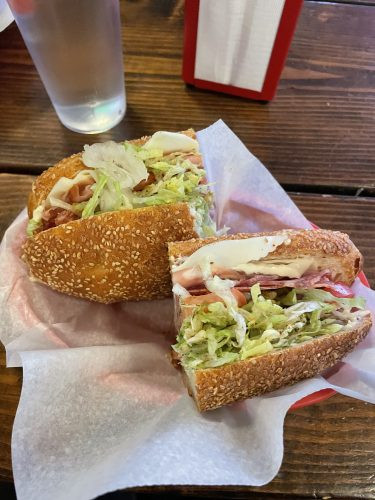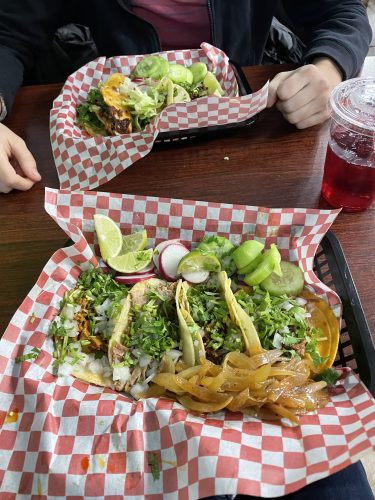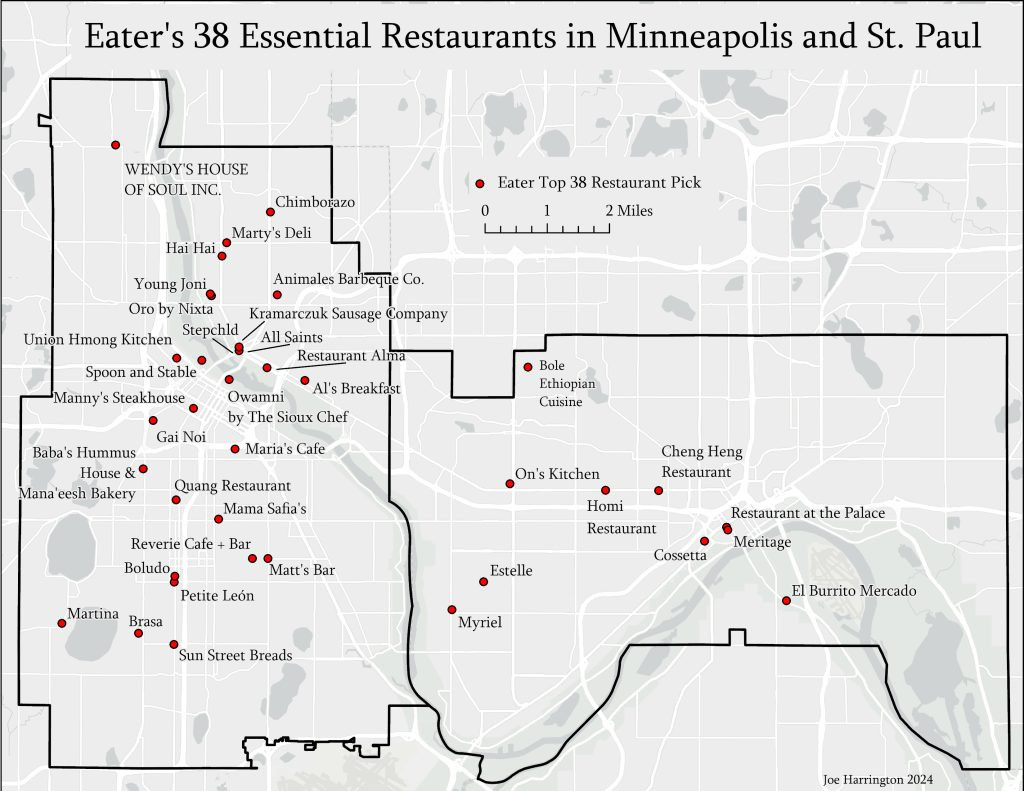Growing up immersed in the rich culinary traditions of Irish and Italian families in New England, food was more than just sustenance; it was the heart of our family life. From my grandmother’s Sunday ritual of slow-cooking pasta and meatballs – a tradition I cherish and continue today – to countless hours spent cooking alongside my mother, who manages several renowned Maine seafood restaurants, my upbringing was deeply intertwined with the world of food. I even spent years working in one of her restaurants, gaining firsthand experience in the bustling environment of the culinary industry.
This deep-rooted passion for food became a primary lens through which I explored the Twin Cities after moving here for college. Minneapolis and St. Paul, with their diverse neighborhoods, beckoned with the promise of new culinary discoveries. Living in St. Paul’s Mac-Groveland neighborhood, a vibrant area near colleges and major bus routes, I found myself with an endless array of dining options. From the quintessential Italian sub at Mario’s to the flavorful curries at Spice and Tonic, the smoky brisket from Black Market BBQ, the savory Lengua tacos at Oro by Nixita, the satisfying Bahn Mi from Ipho by Saigon, and the perfect scoop of ice cream at Pumphouse, each meal became a delicious exploration of my new urban landscape.
 Italian Combo sandwich shown in a plastic tray at a table in Mario
Italian Combo sandwich shown in a plastic tray at a table in Mario
A street view of St. Paul’s culinary scene: The iconic Italian Combo sandwich at Mario’s, an East Coast-style delight considered by many to be the best sandwich in the Twin Cities. Captured in a neighborhood eatery, this image embodies the local flavor.
Minneapolis and St. Paul are truly cities defined by their distinct neighborhoods, each possessing its own unique charm and identity. These neighborhoods serve as gathering points for residents, often centered around local restaurants and bars. As beautifully articulated in the insightful 2019 book by Streets.mn co-founder Bill Lindeke and Andy Sturdevant, these local establishments are instrumental in forging a neighborhood’s sense of place and belonging. They become the backdrop for shared stories and foster strong community identities deeply connected to beloved local favorites. These aren’t just places to eat; they are cornerstones of neighborhood identity, offering a unique street-level view into the soul of each community.
This identity formation manifests in various ways across the Twin Cities. In Northeast Minneapolis, for example, it emerged organically. A cluster of nationally recognized restaurants – including Young Joni, Hai Hai, Oro by Nixita, Diane’s Place, and Restaurant Alma – coalesced, transforming the arts district into a celebrated restaurant destination. This concentration of culinary excellence has made the neighborhood a highly sought-after and trendy location for aspiring restaurateurs looking to establish themselves in a vibrant and dynamic environment. The Street Views here are punctuated by the buzz of acclaimed eateries, reflecting a neighborhood defined by its culinary reputation.
A similar phenomenon can be observed in the restaurant scenes along University Avenue in St. Paul, particularly in the stretch between Snelling and Western, and in Cedar-Riverside in Minneapolis. In these areas, more affordable rents and the presence of vibrant immigrant communities have cultivated a rich tapestry of diverse culinary offerings. These streets offer a different kind of street view, one characterized by culinary diversity and the authentic flavors of immigrant cultures, contributing to the unique character of their respective neighborhoods.
 Steak Bahn Mi and Pho shown atop a table at IPho by Saigon.
Steak Bahn Mi and Pho shown atop a table at IPho by Saigon.
A street-level snapshot of University Avenue, St. Paul’s diverse food scene: Hearty Soup and a flavorful Steak Bahn Mi at Ipho by Saigon. This image captures the essence of affordable and vibrant dining options found along this bustling street.
This pattern of organic culinary growth extends to numerous other neighborhoods throughout the Twin Cities. From East Lake, Kingfield/Fulton, and Uptown in Minneapolis to West 7th, Grand Avenue, and Frogtown in St. Paul, and many more neighborhoods across the metro area, local restaurants are intrinsically linked to the identity and street view of their communities.
In contrast to organic growth, some neighborhoods have intentionally cultivated restaurant-driven identities. A prime example is Eat Street, the stretch of Nicollet Avenue extending roughly from Franklin Avenue to the former Lake Street Kmart. In 1997, the Whittier Alliance spearheaded a neighborhood revitalization initiative, strategically rebranding this section of Nicollet as “Eat Street” – a deliberate place-based management strategy. Over the ensuing decades, restaurants have become the defining characteristic of this neighborhood, transforming Eat Street into one of Minneapolis’ most dynamic and celebrated dining destinations. The street view of Eat Street is intentionally curated, a testament to the power of place-based branding in shaping neighborhood identity through food.
Navigating the Local Restaurant Scene: Finding Your Street View Favorites
For newcomers and visitors alike, especially those with a passion for food and a tendency to overthink dining choices, delving into a local restaurant scene can feel like a daunting task. While word-of-mouth recommendations are often invaluable, as a transplant to the Twin Cities without an extensive local network, I initially turned to online restaurant guides to orient myself.
Restaurant guides play a crucial role in organizing a city’s vast and often overwhelming array of restaurants into curated, digestible lists. The Twin Cities are fortunate to be featured in countless such guides, ranging from expansive national websites to hyper-local media outlets, blogger recommendations, and crowdsourced platforms. These guides serve as essential tools for both residents and visitors seeking to understand the culinary street view of the city.
 Tacos in a plastic lined tray shown atop a table at Taqueria y Birrieria las Cuatro Milpas.
Tacos in a plastic lined tray shown atop a table at Taqueria y Birrieria las Cuatro Milpas.
East Lake Street’s authentic flavors: Tacos presented in a traditional plastic-lined tray at Taqueria y Birrieria las Cuatro Milpas in Minneapolis. This image offers a glimpse into the unpretentious and delicious street food experiences available in the neighborhood.
Restaurant guides are not only valuable sources of local information but also serve as a significant tourism strategy for cities. Prestigious guides like the MICHELIN Guide can bring immense recognition and elevate the culinary reputation of a city. Some cities, like Denver, have even invested in attracting the MICHELIN Guide to assess and rank their restaurants. While the Twin Cities hasn’t actively pursued Michelin recognition to the same extent, the Minneapolis Downtown Council is considering it as part of its 2035 revitalization plan. This possibility has sparked local discussions about which Twin Cities restaurants might be potential Michelin star recipients, further highlighting the growing culinary street view of the region.
Upon arriving in the Twin Cities, I initially relied on Eater and the Star Tribune as my primary resources for navigating the local food scene. Eater’s “38 Essential Restaurants in Minneapolis and St. Paul” guide, updated quarterly, offers a curated list of both established favorites and exciting new establishments. Eater, a national food news site and guide creator, provides similar lists for cities across the country, from Denver to Dallas and Miami, and of course, Minneapolis and St. Paul. Curated by their experienced food editors, this list proved to be an invaluable tool in my initial exploration of Minnesota’s culinary landscape, providing a well-informed street view of the current dining scene.
The Eater list showcases a range of dining experiences, from trendy hotspots to award-winning establishments. Restaurants like Owamni, Hai Hai, Young Joni, Spoon and Stable, and Restaurant Alma, all recipients of prestigious James Beard Awards, are prominently featured. Numerous other restaurants, bars, and bakeries have also received James Beard nominations, further solidifying the Twin Cities’ growing culinary reputation and enhancing its national street view.
Restaurants such as Oro by Nixta, Gai Noi, and Petite León have garnered national acclaim, recognized on the New York Times top 50 restaurants list. Vinai, while not on the Eater list, was independently recognized as one of Eater’s best new restaurants in 2024. These national accolades contribute to a broader street view of the Twin Cities as a rising culinary destination.
The Eater list also thoughtfully includes long-standing local favorites such as Maria’s Café, Matt’s Bar, Cheng Heng, Bole Ethiopian Cuisine, Al’s Breakfast, and Chimborazo, spanning both Minneapolis and St. Paul. This blend of new and classic establishments provides a comprehensive street view of the Twin Cities dining scene, encompassing both innovation and tradition.
 Map of Minneapolis and St. Paul with Eater
Map of Minneapolis and St. Paul with Eater
Eater’s street view of the Twin Cities dining scene: A map highlighting the locations of restaurants featured in Eater Twin Cities’ “38 Essential Restaurants in Minneapolis and St. Paul” for Quarter 4, 2024. This map offers a visual guide to exploring the city’s top culinary destinations.
Local newspapers are another essential resource for discovering curated restaurant lists. The Star Tribune, a major Minnesota newspaper, offers its own perspective on the Twin Cities dining scene. Initially, I consulted their “40 restaurants that define Twin Cities dining.” Published in 2022, this list highlights long-established eateries throughout the cities and even includes a few suburban establishments, presenting a different street view focused on culinary history and local institutions.
 Map of Minneapolis and St. Paul with the Minnesota Star Tribune
Map of Minneapolis and St. Paul with the Minnesota Star Tribune
Star Tribune’s historical street view of Twin Cities dining: A map based on the Minnesota Star Tribune’s 2022 “40 restaurants that define Twin Cities dining” list. This map emphasizes long-standing establishments that have shaped the city’s culinary identity over time.
This Star Tribune list offers a contrasting street view of Twin Cities dining compared to Eater’s list. It emphasizes longevity and tradition, showcasing establishments that have shaped the local dining culture over decades, while often overlooking newer, trendier spots. Featured restaurants range from St. Paul’s Moscow on the Hill and Mancini’s Char House to Minneapolis’ Barbette, Broders, and Bryant Lake Bowl, representing a different facet of the Twin Cities culinary landscape.
Contrasting Culinary Perspectives: Different Street Views from Different Lists
Examining the overlap between the Eater and Star Tribune lists reveals interesting insights. Out of a combined total of 78 restaurants, only three appear on both lists: Cossetta, El Burrito Mercado, and Alma. This limited overlap underscores the distinct perspectives and curatorial approaches of each publication, offering different street views of the Twin Cities dining scene.
Eater tends to favor Northeast Minneapolis, featuring nine restaurants compared to the Star Tribune’s five in that neighborhood. Conversely, the Star Tribune places greater emphasis on downtown Minneapolis, with nine restaurants listed versus Eater’s two. Both guides recommend ten St. Paul restaurants, but their geographical focus within St. Paul differs. The Star Tribune leans towards downtown and West Seventh, while Eater highlights University Avenue. Notably, both lists exhibit gaps in coverage, particularly in North Minneapolis and East Side St. Paul, suggesting areas for further culinary exploration and discovery, offering a more complete street view in the future.
Ultimately, the discrepancies between these lists reflect their distinct editorial objectives. The Eater list aims to capture the current pulse of Twin Cities dining, showcasing both acclaimed newcomers and enduring favorites that represent the region’s evolving culinary landscape. It provides a dynamic and contemporary street view of the food scene. The Star Tribune’s classics list, on the other hand, prioritizes longevity and tradition, celebrating establishments that have significantly shaped local dining culture over many decades, offering a historical street view.
Both publications also provide a wealth of other culinary lists, covering a wide spectrum of topics. From the Star Tribune’s regular feature “Five Best Things We Ate This Week” to Eater’s highly specific guides to the best bowl of ramen or fried chicken sandwich, these resources cater to diverse culinary interests and preferences. They collectively contribute to a multifaceted street view of the Twin Cities dining scene, catering to every palate.
However, perhaps the most rewarding way to truly discover the Twin Cities dining scene is to venture beyond curated lists and embrace personal exploration and word-of-mouth recommendations. Whether it’s following enticing aromas emanating from a University Avenue storefront, seeking recommendations from local friends about their neighborhood favorites, or simply stepping into a family-run restaurant that catches your eye, the most memorable dining experiences often arise from venturing off the beaten path. These spontaneous discoveries offer a truly authentic street view of the city’s culinary heart.
After living in the Twin Cities for five years, my friends and I have cultivated our own cherished collection of neighborhood restaurants, bars, and coffee shops, many of which have remained undiscovered by any prominent restaurant guide or list. These hidden gems, often found through personal exploration and local insights, represent the true, unfiltered street view of the Twin Cities’ vibrant and diverse culinary landscape.
After all, every long-time favorite or critically acclaimed hotspot began as someone’s personal neighborhood discovery, waiting to be found and appreciated, one street view at a time.
Editor’s note: “Street Views” appears in Streets.mn twice monthly. Respond to columnist and board member Joe Harrington directly at [email protected]. You may also add comments at our Streets.mn pages on Bluesky and Facebook.

